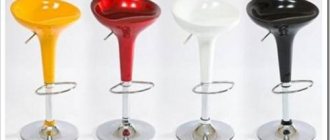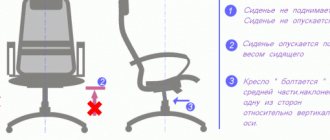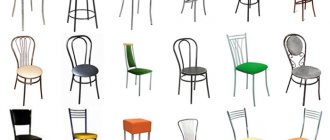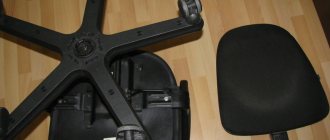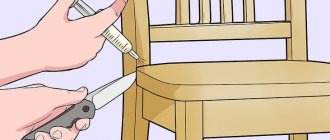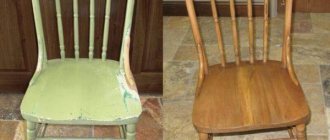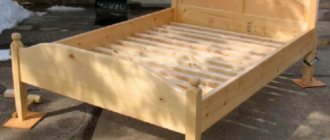High chairs are varied, produced in a wide range of styles, materials and additional features. Some of them have interesting “bells and whistles”: rocking chairs, inflatable seats, etc. Therefore, before you make the chairs taller, you should familiarize yourself with all the models that are popular.
A high chair is placed in the swimming pool, billiard rooms, living rooms and dining rooms. The wide range of fabrics and finishes, as well as other parameters such as height and custom footrests, make it a piece of furniture that requires a personal touch, in most cases, models are made by hand.
How to extend chair legs?
Extending chair legs is not as simple a task as it might seem at first glance.
The chair leg is a complex detail. Different styles of furniture correspond to a variety of leg shapes. In the Baroque style there are twisted columns or volutes, Rococo offers legs in the form of whimsically curved cabrioles, and in classicism there are strict straight legs, rectangular or round in cross-section of the column. When making a chair or armchair, it is important to cut out the legs correctly. Wood is not a homogeneous material and it is necessary to cut the stem in such a way that the annual layers run strictly vertically, otherwise a “cross-cut” defect will form and the stem will definitely break at this point. It is useless to repair such a chair leg; it will break again and again. Such a part can only be replaced with a new one, correctly made. Antique chairs, like any other furniture made of wood, are subject to deformation. As a result of natural warping, the geometry of the object changes. The legs change shape, one of them bends and becomes shorter. The chair begins to wobble and, to eliminate this defect, one of the legs of the unfortunate chair is filed down. A non-specialist rarely succeeds in doing it exactly on the first try. The second and all subsequent attempts to level the chair by filing the legs lead to a decrease in the overall height of the chair.
The next reason for reducing the height of chair legs is the breakdown of the wheels. Seating furniture from the first and second Rococo periods was made using bronze cups. The glass was placed on the leg along with a bronze, ebonite or wooden wheel attached to it. It was considered especially chic to move furniture on front legs with wheels, lifting it by the back. Sometimes on a chair or armchair, wheels were made only on the front legs. So the upholstered furniture was more stable. The wheels broke, they were removed, and to level them, the legs of the chair were driven according to the markings under the front legs without wheels. The chair or armchair became low.
To extend a chair leg you need: a block of wood, a suitable size for the type of wood from which the chair itself is made, glue, preferably carpentry glue, a set of tools for wood carving, a drill with a wood drill bit, dowels made of hard wood, clamps, stain and varnish .
A block of wood of a suitable shape is glued to the extension leg. The wood fibers must run strictly vertically relative to the floor. The joint is reinforced with a hardwood dowel. Typically beech. After the glue has dried, the wood is given the required shape using hand cutters. The adhesive connection must be strengthened, that is, made more durable.
To strengthen the connection with a drill, from the side of the new wood, that is, from the floor up, a hole with a diameter of 10-20 mm and a length of 30-40 mm longer than the glued block is drilled. The hole should go through all the glued wood and into the old leg. Next, a dowel is inserted into this hole with glue along the entire length of the hole. After the glue has dried, the dowel is cut, the added part is tinted and finished with varnish.
Legs of complex shapes are extended with specially shaped inserts, which allow increasing the area of the bonded surface. Sometimes chair legs are damaged by wood beetles or destroyed as a result of improper storage in a damp room. The wood itself becomes unusable, becomes loose, brittle, and breaks easily. In this case, you can extend the legs of the chair, but you will no longer have to sit on such a chair. I have to make a new leg.
A course in the restoration of wood products in the workshop of Elena Zhilina. Sign up by our phones.
Sincerely, Elena Zhilina.
Restoration of paintwork
| Finishing | RUB/sq. meter |
| Waxing | 500 |
| Polishing | 1500 |
| Shellac | 2000 |
| Gilding | 3000 |
Restoration of decorative coating
| Finishing | RUB/sq. dm |
| Patination | 50 |
| painting | 200 |
| Marquetry | 500 |
| Mosaic | 1000 |
Feedback form
By sending us a completed form with photographs, as well as asking a question, you will receive complete information about the item (what it is, material, age) and the cost of restoration work. Next, the restorer will come to the site, inspect it, and determine the final price of the restoration.
The final price will not change. Departure is free.
Source
Chair repair and strengthening. Part 4: strengthening the chair frame
The fourth part of the master class is coming. It will focus on strengthening the chair frame.
There are many methods to strengthen the frame of a chair. But, in relation to our specific case, it is only possible to strengthen the four connections of the drawers with the legs of the chair. Let's dwell on this technique.
Our chair has reinforcement elements - these are four spacers glued into the drawers on the back side of the seat.
But, in my opinion, and as can be seen from the practice of using chairs, these spacers alone are not enough to ensure sufficient strength of the chair frame. Therefore, we will strengthen these nodes.
Since the side drawers have an angular slope in relation to the rear back and, as a consequence, to the side surface of the square leg, I decided to somewhat simplify the strengthening process, to do it in two stages.
First, cut out and fit narrow boards to the sides.
Then fit the corner bars under them so that they fit the shape of the edges of the spacers.
Now I made the first gluing, first gluing, using clamps, the fitted blocks to the inner surfaces of the frames.
While the glue was drying, I continued with the prep work before the second gluing. In order for the reinforcement to be very strong, in addition to gluing, I decided to also use the corners I adjusted for screws that will be screwed into the legs of the chair. To do this, you need to drill holes in the corners, directly perpendicular to the inner edge of the chair leg (along the bisector of the obtuse angle of the corners).
The screws will have a diameter of 6 mm and a length of 70 mm, so I took a drill with a diameter of 5 mm. In order to tighten the screws better and more correctly (it is necessary to insert the screw into the leg by 1.5 - 2 cm), the corners attached to the front of the chair had to be additionally drilled from the outside with a drill with a diameter of 10 mm so that the screw would enter there into the countersunk to a depth of 2 - 3 cm, and then into the leg. I did not need to do such an operation for the back corners, since their size turned out to be smaller than the size of the front ones.
And so that the head of the screw was hidden in the back two corners, I used the same drill to drill a small recess in them too.
Now the corners prepared in this way can be glued to their intended place. But in order for the gluing to be very strong and to prevent damage to the chair legs when working with the clamp, a special lining had to be made on the outer surface of the leg.
We smear the side edges and the part of the corner that rests on the spacer, glue and gluing.
After the glue has dried
All that remains is to use a screwdriver to drill our legs to a depth of 1.5 - 2 cm so that the screw can easily fit in when screwing. This is easy to do now - we have a guide hole.
And screw our screws in there.
In principle, it is possible to make reinforcements without first gluing small boards, but, in my opinion, fitting the reinforcing corners, so to speak, in a “whole” form, with making templates for all four blanks, will take no less time, but will produce more waste during work, because when fitting, you have to “catch” the corners with great precision. The production of templates will have to be done individually for each chair and reinforcement unit, because Despite the fact that the chairs are made in factory conditions, the variation in the sizes of certain parts is quite decent.
To complete the repair work, all we have to do is upholster the chair, but more on that in the next part of the master class.
Required materials and tools
You will need the following tools and materials:
- a wooden block, preferably from the same material as the chair;
- glue (preferably carpentry glue);
- wood carving cutters;
- dowels made of hardwood (usually beech is used in this capacity);
- drill, wood drill;
- clamps;
- stain of a suitable shade, varnish.
Leg position
You can determine the correct position of your computer chair by looking at the position of your legs. When seated correctly, a space the size of a finger is created between the thigh and the seat. If the gap is smaller, then the chair should be lowered. A good footrest will also help in this situation. A computer chair may fit fine, but if you are tall, there will be more space between the seat and your thigh. It is better to raise the chair to close the gap.
You can check the seat depth by trying to place your fist between the back of your shin and the adjusted seat. In the correct position, the fist moves freely. If the landing is too deep, it is difficult to pass the shot. In this case, it is necessary to re-adjust the product. Some seat models have a lever on the right that allows you to adjust the depth of the seat.
Sometimes too much distance is created between the shin and the edge. This indicates that the backrest is in the wrong position. You can adjust its position using the lever. If you cannot solve the landing problem, you will have to use special pillows and padding for the chair. It is enough to buy an orthopedic pillow to avoid back pain and other problems.
Step-by-step instruction
The work is carried out as follows:
- Glue the wooden block to the chair leg so that the location of the fibers in relation to the horizontal surface of the floor is vertical.
- Clamp the resulting structure with clamps and hold until the glue dries completely. After this, use cutters to give the block the desired shape.
- From the side of the glued part (from the floor up) in the cavity of the leg, drill a hole with a diameter of 10–20 mm and a length of 30–40 mm further from the block so that it passes through the glued part of the structure and enters the old leg.
- Coat the dowel with glue and place it along its entire length inside the resulting hole.
- When the glue dries, cut the dowel. Tint the added part and then coat it with varnish.
Seat adjustment
The main principle of seat adaptation is to achieve maximum back-to-back contact. To do this, you need to sit, occupying the entire surface of the chair. Many modern models have a shape that makes it impossible to get into the wrong position. The seat depth is adjusted using a slider. The presence of a depth adjustment device indicates a serious approach to the development of a high-quality computer chair from the manufacturer.
Computer chair control mechanisms
Grow your legs
The method of increasing the height of the legs depends on the material from which they are made:
- For metal ones, you need to purchase tubes of a slightly larger diameter, cut a piece of the required length and insert a leg into it. Secure the element with screws, having previously drilled holes of the required diameter.
- For wooden ones, select bars of a suitable size or ready-made parts and attach them to the bottom of the legs with wood glue. To strengthen the fastening of self-made parts, from the side of the new element, drill a hole with a diameter of 10–20 mm of such length that the dowel inserted into it goes through and goes a third deep into the main leg. Ready-made options simply screw into the leg
CHAIR ON WHEELS
It's nice when the whole family gathers at the dinner table. To make this possible, we recommend making a chair on wheels for elderly family members. This chair will become even more comfortable if you attach a footrest to it. If the carpets in your apartment have long pile, you must use wheels with a diameter of 50 mm or more.
Material A. Base – plywood (dimensions are shown in the figure). B. Planks for corners - bars 25 mm x 25 mm x 75 mm, 8 pcs. S. Wheels. D. Wheel mounting blocks. Gluing and screw fastening.
Operating procedure1. Secure the corners of wooden planks as shown in the picture. 2. Secure the blocks on which the wheels will be mounted. 3. Place the wheels on the blocks. 4. Sand the wooden parts and paint.
Attach wheels
Installing ball-type wheels on the legs will help increase the height of the chair and at the same time make it mobile. To fasten it, you need to drill a hole in the center of each base and screw a new element with a self-tapping screw. Wood glue will help increase the strength of the connection.
A chair with wheels should not be used by people with impaired functioning of the musculoskeletal system.
COMFORTABLE WOODEN CHAIR
We offer you several ways in which you can make an ordinary chair more comfortable. Material: 6mm plywood. It makes sense to make the chair in the kitchen more comfortable, and then you can cook while sitting. For strength, we recommend fastening the armrests with screws, which requires making holes in the legs of the chair.
Place a cushion on the seat
The simplest and at the same time safest way to increase the height of a chair is to place an additional cushion on the seat.
- To make it, take 2 squares with sides corresponding to the size of the seat, sew them together, leaving one side.
- Then put the filling inside and stitch the rest.
- Sew braid or ribbon to match the base material to the back corners to secure the cushion to the chair legs.
- To make it more decorative, tighten the opposite sides of the product with a seam passed through the filler.
When increasing the height of a chair, it is important to consider its stability to ensure safe use. Furniture must be able to withstand rocking or shaking. Sometimes, for reliability, it is advisable to screw the chair to the floor.
Source
BACKREST
This device is designed for chairs with soft backs. Dimensions depend on the modification of the seats.
MaterialA. Back - plywood 4 mm x required height x width of the back of the chair. B. Thick fabric - width equal to the width of the back x 350 mm. C. Ties - 2 m braid.
Operating procedure1. Cut off the corners of plywood A. 2. Sand all corners with sandpaper. 3. Sew the loops for the ties. 4. Glue the fabric onto plywood A. 5. Sew ties B to fabric A. 6. Place backrest A at the required angle and tie it to the base of the chair, as shown in the picture. 7. Place pillows on the back and seat of the chair.
Top 3 ways to make a chair taller
High chairs are varied, produced in a wide range of styles, materials and additional features. Some of them have interesting “bells and whistles”: rocking chairs, inflatable seats, etc. Therefore, before you make the chairs taller, you should familiarize yourself with all the models that are popular.
A high chair is placed in the swimming pool, billiard rooms, living rooms and dining rooms. The wide range of fabrics and finishes, as well as other parameters such as height and custom footrests, make it a piece of furniture that requires a personal touch, in most cases, models are made by hand.
Pads for chair legs: what they are, what to make, where to buy
- Why are overlays needed?
- Varieties of legs
- Materials used
- We do it ourselves
Hi all! I think many people are familiar with the problem of floor coverings being damaged by the legs of chairs, tables and other furniture. It can be solved by padding on the legs of chairs, the so-called heels.
These linings are offered in a wide range and are made from various materials. But they always perform the same function. This protects the floor covering. Plus, the design of the furniture support legs themselves is additionally protected.
They are not at all difficult to make and install with your own hands.
Children's models
Standard
This is an everyday high chair with tray that can be used as soon as your baby can sit (around six months of age) or even earlier if the model reclines. A special tray serves as a table for the child.
European style
This is a high chair that is pulled right up to the dining table so that the child can eat with the rest of the family. As a rule, it is suitable for a one-year-old baby and a child over a year old; such designs are best made with an adjustable seat.
Hook chair
This model, which can hardly be called a chair, is great for travel and for families with limited living space who live in a small area. This type of compact clip-on seat that attaches to a table or regular dining chair. When making such a model, you need to make sure in advance that the furniture on which it will be attached is strong enough.
Bar models
Many of us associate bar stools only with public places, but isn't it worth creating a spontaneous and relaxing atmosphere right at home? The proportions of bar stools make them suitable for more than just pubs.
A type of high chair, often with an additional leg support, allows you to sit higher when eating, drinking, or socializing. In the 2000s, it became popular in apartments; models are placed on the kitchen island and form a home bar. And if you are a party fan, spend long evenings with friends, or are simply looking for an interesting idea to liven up your space, then a bar at home is the idea for you.
The solution was invented for those who like to have a snack on the run, who prefer to communicate in a relaxed atmosphere. When creating models, they use interesting approaches, the space acquires a completely new atmosphere.
- The bar counter quickly becomes the familiar heart of the apartment; over time, it will be difficult to convince guests to take a seat at the table. The kitchen is made open. This layout will provide flowing space, the ability to move around the dining island.
- Even in a small kitchen of a one-room apartment, you can allocate space for a bar counter, at which two people can sit comfortably; this is a smart way to use a small area.
- They are planning a bar in the basement of a private house. Here it is easier to maintain the required temperature for exceptional wines.
Changing the seat height
The optimal seat position is determined in an upright position: its highest point should be just below the knee. In this case, in a sitting position, the elbows of the seated person, resting on the surface of the table, should form a right angle. This is the optimal position for long-term work.
Black computer chair with adjustable backrest
The “gas lift” mechanism is responsible for the height of the seat. Optimal comfort is achieved when the thighs are positioned at a 90° angle to the shin. To change the height of the desk chair, you need to use the lever, which is usually located on the left side under the seat. In a sitting position, pull the handle up. To increase the height of the backrest, you will need to stand up, then the height of the seat will begin to increase. When the structure acquires the required position, you need to make sure how correctly the product was secured. Knowing how to lower the chair, you can do it without getting up - just pull the lever.
Breathable computer chairs
Some models (instead of a lever) may be equipped with a rotary control, which must be turned to bring it to the desired position. If the owner cannot figure out how to lower or raise an office chair, one of the following will help solve the problem:
- The product has two regulators, each of which is responsible for a specific action: lowering or raising. Therefore, it is recommended that you read the instructions first.
- You may have a pneumatic model that needs to be rocked before lowering/raising.
- The rotating arm can only rotate in one direction. If the chair rises during adjustment, you must continue to rotate. After rising, it will begin to descend.
Multifunctional computer chair
In this case, the legs must have a strong support underneath them. Legs suspended in the air will not provide the necessary back relief, so the computer chair must be adjusted so that the legs are at a 90-degree angle and the heels rest on the floor or footrest.
Computer chair with orthopedic back
What types of designs are there?
When thinking about how to make a bar stool, take into account that models are made with or without armrests, with or without a backrest, with upholstery on the seat surface and with hard seats. Stools save space. Furniture ranges from basic wooden structures to more complex, height-adjustable designs.
Swivel and floor models can be moved, but they are unstable. Mounting to the floor makes the furniture immovable. This floor-standing option is usually mounted on a column, and if the chair has legs, it is secured to the floor using metal brackets.
Bar stools are produced in various styles. Remember! You and only you limit your imagination.
- Most often, wood is used to make it yourself.
- Some bar models use polyurethane foam as a comfortable upholstery.
- Wooden and metal tall models (including stainless steel), height-adjustable, are especially popular.
- Furniture is made from rattan or bamboo, using it to create the effects of the popular retro style of the 1950s and 1960s.
- Some craftsmen use chrome in combination with matching seats.
How to independently adjust a computer chair?
The vast majority of office chairs are equipped with a classic set of components:
- Gas lift, responsible for adjusting the seat height.
- The swing mechanism is fixed in a certain vertical position.
- Cross or five rays.
- Armrests.
- Wheels.
Before adjusting a chair, you should study it carefully, as some do not have certain mechanisms.
Comfortable computer chair in pastel colors
How to increase the height of an existing model
Depending on the design of your existing chair, you can significantly increase its height. In one case, this will help to combine with other furniture. In another, a taller chair will make life easier for older people and people with physical limitations who have difficulty sitting down and standing up.
Attention! For some types of chairs, neither method is suitable and none is safe.
"New Legs"
Upholstered, lightweight chairs and stools often have legs that are screwed on. You can make or even buy replacement legs in a variety of styles and a wide range of lengths to increase the height of your chair. The main thing is that the thickness of the new element is similar to the original. Replacing a wide support with a narrow one will cause instability and will make the furniture unsafe.
Why are overlays needed?
The question may seem strange, but it is really necessary to answer it.
This is a kind of fittings designed to improve your furniture. Specifically chairs and stools.
There are several functions that the pads on chair legs perform:
- Floor covering protection. This is the main task facing products of this type. The legs of the chair, due to the nature of the material and the weight of the user, can cause damage to the coating. The legs eliminate this drawback;
- Reduced noise levels. Also, many people install pads to prevent chairs from making noise when moving. A striking example is a bar stool made of wood or metal that stands on tiles;
- Help with moving. You don't have to lift a heavy chair and drag it across the room. The soft pad allows you to pull furniture through. Although with chairs this is not the primary concern of the heels;
- Increasing resilience. Some chairs slide easily on the surface, which is not safe when trying to sit or stand on them. For the same step stool, an anti-slip pad is a must.
Master class on making a pillow
Cushion pillows, soft, large, small, multi-colored, plain... They can change any interior and give it character, and at the same time they are practical and comfortable.
- textile,
- threads,
- scissors,
- needles,
- sewing machine,
- filling (silicone).
From the selected fabric, cut out two squares measuring 50 x 50 cm and four strips 52 cm x 10 cm (1 cm for seams). The parts are sewn together, leaving a 10 cm hole. If you want the edges of the pillow to be more visible, the seams are made at a greater distance from the edge.
Initially, after filling with silicone, the pillow will not be too beautiful, so it makes sense to give it the shape of a saddle. It is enough to pull the opposite sides of the product towards each other in several places with a large needle.
These cushions, which can vary in size depending on the size of the chair, are ideal for playing directly on the floor.
DIY office chair repair: instructions with video
A modern office chair is a functional and comfortable piece of furniture, equipped with a rather complex mechanism that sooner or later fails. In such a situation, there are three options for the development of events: buy a new one, deliver it to a specialized workshop, or repair the office chair yourself.
As practice has shown, it is quite possible to do this work yourself. The only thing that is required from the master is strict adherence to the sequence of actions and implementation of the instructions that will be provided in this publication.
How to choose the right material
In the photo of hand-made chairs you can see that different models use different wood. They are also used in different spheres of human life and are located in different rooms. Choosing a material is the first serious step towards making your own product.
It is necessary to decide which type of wood is most appropriate to use in a particular case, hard or soft. If the choice fell on hardwood, it is represented by such species as oak, walnut, cherry, birch and maple. They have fairly high strength and resistance to cracking and deformation.
However, they are quite difficult to treat with additional means due to the very dense structure of the fibers. Hardwoods are quite expensive, but they are completely worth the cost.
If the choice fell on soft tree species, then these are linden, pine, alder, spruce and many others. They have a lower market value, but are more susceptible to various physical influences.
They also have a lower fiber density, which will release resin that can stain clothing. They are also more susceptible to fire and drying out. To prevent this, they must be treated with special means at least 2-3 times. Products from such rocks are very light and beautiful, hard and stable enough for everyday use.
As a rule, timber of one or another species is purchased for making furniture. Boards are also often used. You can purchase them at any hardware store. Buying ready-made bars and boards can significantly save time. If you wish, you can independently form boards and bars from logs, but the cutting process requires certain skills and knowledge of a carpenter.
When choosing ready-made materials, you need to pay special attention to their appearance. It immediately becomes clear whether the conditions for the preparation and storage of materials were observed. There should be no cracks or chips on the surface, and no resin should appear. The shape of the material should not be disturbed by bends or irregularities.
How to avoid mistakes when adjusting
The chair needs to be adjusted carefully. Make sure you are sitting comfortably, enter text on the keyboard, read the text on the monitor. If necessary, the position can be adjusted during operation.
If you install your computer chair correctly, the monitor will be directly at eye level.
Often the chair is installed incorrectly, this can be understood by the sitting posture. A hunched back and forward torso are the first signs of failure.
- The chair is too high or too low.
- Incorrect position of the armrests.
- Incorrect backrest angle.
- The seat is too wide or narrow.
It is advisable to pay attention to models in which the back and armrests are adjustable with screws.
The body itself tells you what to look for. If your back or neck hurts, check your back angle. Wrist pain may indicate problems with the armrests or chair height. And my legs went numb - they were at the wrong depth of the seat.
Handle your office chair with care.
We must customize the office chair for ourselves, this also applies to the home computer chair. Prolonged sitting harms the spine; due to the ergonomics of the workplace, you can at least slightly reduce the negative impact.
Adjusting the chair is easy and only takes a few minutes.
Modern office chairs have a number of adjustments that need to be tailored to your needs. In this case, it is necessary to monitor the position of the body. If you follow all the rules, you can avoid mistakes and maintain your back health.
Adjusting the armrests
The armrest adjuster is usually located on the left side. To adjust, you need to hold down the button, then lower the armrests to the required height, after first releasing the pressed button.
Adjusting the armrests of a computer chair
The tilt of the armrests is adjustable with a screw. When sliding, the inclination of the armrests changes. If this is not provided for by the design, you can do this using a regular screwdriver.
When working with an office chair for a long time, during which your hands are constantly on the table, it is important to correctly adjust its height and orientation. A comfortable position is when your elbows are at an angle of 90°. If support is not required or a comfortable position cannot be achieved, it is best to remove these parts of the product or position them in such a way as not to cause discomfort to the person sitting.
Adjustable computer chairs
Current models of office chairs in 2022 suggest the presence of other additional control parameters. In particular, the armrests may move or move away from each other. In addition, certain modalities can be offered to a sitting person, the number of which can vary from 3 to 10.
How to adjust the chair's rocking mechanism?
First you need to find out the rigidity of the required swing. Its size is selected based on the weight of the sitting person. If the computer chair was purchased for a child, the corresponding spring can be loosened. If we are talking about the chair of a leader or an adult weighing more than 90 kg, then it must be tightened as much as possible. The chair is adjusted by turning the corresponding knob counterclockwise or clockwise until the optimal firmness for the sitting position is achieved.
Premium computer chair
A well-fitted chair supports the sacral spine as it reclines, allowing it to lengthen. The chair's swing mechanism allows you to fix it in the most comfortable position and works like a simulator.
Resting position on a computer chair
The tilt mechanism is most often used in the manufacture of chairs. It is one of the most common and is used to complement seats in the budget and mid-price segment.
Types of chairs: amazing things are nearby!
It would seem that what could be simpler than an ordinary chair? In fact, this piece of furniture has always inspired designers all over the world, who have created endless interpretations of it - for every taste and for all occasions! We have selected the most popular models to look into the history of these “designer delights”.
Chairs are the most popular type of furniture when it comes to decorating the interiors of apartments, offices and most public places. Only with their help can you add comfort and coziness to the room, refresh the interior or add a stylish accent. Many modern chair models have historical roots. The other part is modern interpretations or replicas of the works of outstanding designers; such chairs can become the real heart of a fashionable interior.
To make it easier to understand the huge number of different chairs, they can be divided into groups depending on their purpose:
- Office chairs
- Dining chairs
- Chairs for home
- Bar chairs
- Chairs for cafes and restaurants
- Armchairs (chairs with armrests)
Types of office chairs
Chairs play a big role in arranging an office space. They “greet” visitors and guests, “help” employees work and “maintain the comfort” of participants in negotiations, conferences and meetings. Depending on their functionality, models can have different bases (rollers, sides or legs) and degrees of softness, back height and, of course, design.
Mobile chairs, which have become office classics, were also once a real know-how. Read the history of their appearance in the article “Voltaire's chair” - the history of the appearance of chairs on wheels. Next we will find out where the roots of other types of office chairs come from!
FK chair by Walter Knohl
The FK washbasin chair is a style icon designed by Preben Fabritius and Jørgen Kastholm back in the 1960s. The graphic silhouette and graceful contours of the chair captivate designers to this day, inspiring new creations. Thanks to the original armrests, the chair seems to welcome you with open arms, giving the person sitting in it a feeling of security and comfort.
The EFIR armchair
with a multiblock mechanism is a stylish armchair for royal comfort!
Zig-zag chair
The Dutch architect Gerrit Rietveld called his brainchild a “joke chair” for its monolithic structure consisting of four inclined plates. Later, other designers appreciated the elegance and grace of the monolithic Z-shaped chair and proposed more comfortable and viable interpretations for the interior design of fashion salons and conceptual spaces.
Photo source - wikipedia.org
Echoes of the legendary chair model can be recognized in modern conference chairs on skids that form a triangle with the seat of the chair. For example, the Ferrum CF chair looks sleek and stylish thanks to its curved chrome base.
Chaise longue
Traditionally, a chaise longue is considered an open-air lounge chair. In fact, indoors they can serve as any chair with a deep seat and a support for a comfortable position of the legs. A business version of the chaise lounge is the Belfast double recliner sofa with excellent ergonomics and a folding design for the most comfortable body position and deep relaxation.
Dining Chair Design
This category of chairs is difficult to define by one or more criteria - it includes so many models of different styles and shapes. And if earlier identical chairs “met” at the same table, today’s trend is a combination of different colors, upholstery and shapes in the decor of a modern kitchen. In a word, complete freedom of choice and flight of fancy!
Louis XIV style chair
Upholstered armless dining chairs look both simple and regal with their high backrest. This model has long become a classic in kitchens and restaurants, as well as in living room interiors.
How to do it yourself
To adjust the parameters of the chair, you should carefully study its design. Some models do not have one or another regulation mechanism. And without them it is simply impossible to set a certain angle of the backrest, the height of the seat and both armrests.
The delivery of the furniture product should include instructions that will help you adapt it yourself. However, you can use general recommendations. First you need to decide on the height of the workplace and the depth of the chair. After this, you can begin adjusting the backrest. When everything is ready, all that remains is to adjust the angle and level of the armrests.
Height change
To change the height of the workplace, you need to use the lever, which is usually located under the seat on the left side. Sit in an office chair and raise your pen. Thus, the furniture is lowered to the required level. Next, you need to place your palms on the tabletop, and if it suddenly turns out that they are higher than your elbows, the position of the chair must be adjusted again. To do this, stand up a little and pull the handle again - without any weight load, the seat will immediately rise.
Some seat models may have a rotary adjuster instead of a lever that must be turned to adjust the appropriate seat height.
If the user cannot figure out how to lower or raise a computer chair or office chair and cannot complete the necessary steps, the problem may be:
- This is not a regular model, but a pulmonary one. To raise the chair or, conversely, lower it, you need to shake the lever (press several times).
- The design has two regulators, not one. Each is responsible for a specific mechanism (raising or lowering). In this case, we recommend that you carefully study the instructions before setting up.
- The rotating arm only rotates in one direction. If the chair only rises when you adjust the seat height, you need to keep turning the knob. After a few laps it will begin to descend.
In some cases, the problem may be a design failure. For example, if the height of a chair changes only under the weight of a person (lowers when sitting and rises when standing), then the cause of this phenomenon is a malfunction of the gas cylinder. It will need to be replaced. If the lever on your new computer chair does not work properly (when pressed), it may have been damaged in transit. It needs to be inspected and fixed with pliers.
Back height adjustment
Classic lever
Rotary regulator
Pneumatic model
Backrest tilt
If there is a screw on the back of the chair, it will allow you to recline the backrest. The adjuster should be loosened by turning it slightly counterclockwise, then sitting down and leaning back and forth until you find the most suitable position. After this, you should fix the angle of inclination by turning it in the opposite direction.
Not all office chairs are equipped with screws for adjusting the angle of the backrest: cheap furniture models do not have this function.
Armrest tilt
The armrest adjustment mechanism is usually located on the left side. To adjust the height, you need to press and hold the button, then raise the armrests to the desired level and then release the pressed button.
Another question is how to adjust the tilt. This is done with a special screw. When you slide it, the angle of the armrests will change. If such an adjustment mechanism is not provided by the design, then the actions can be performed using a regular screwdriver. You must follow the instructions so as not to break fragile parts.
To work at a computer or any other activity in which a person’s hands are constantly on the table, it is necessary to adjust the height and angle of the armrests. It is important that the worker's elbows are at a 90 degree angle. If support is not required, it is best to remove or expose these structural parts so they are out of the way (lower or tilt as much as possible at a 45 degree angle).
Some office chair models also offer various adjustment options. For example, the armrests can be extended and moved relative to each other. In addition, the user can be given the opportunity to select certain modes, the number of which varies from 3 to 10.
Armrest height adjustment
Types of armrest adjustment
